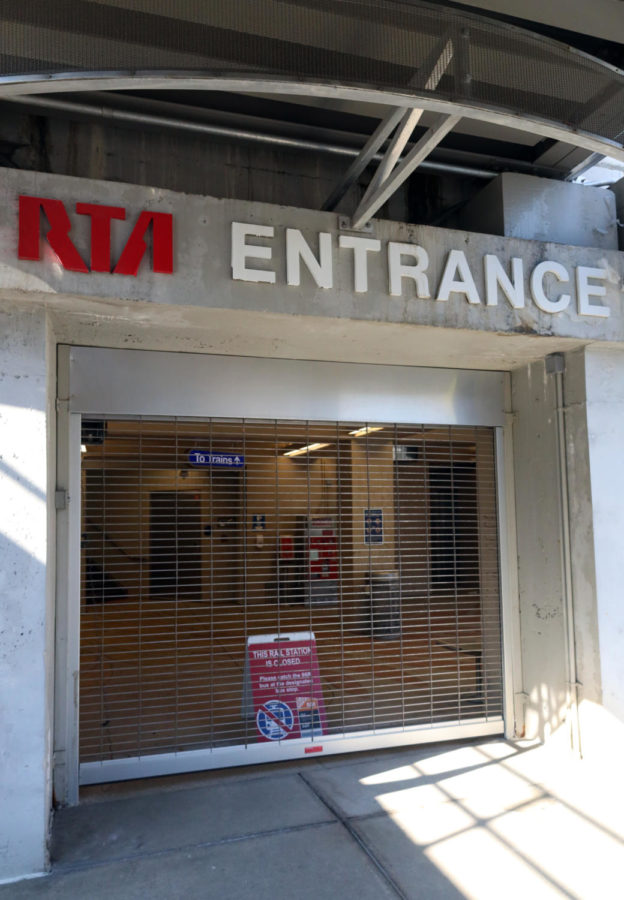RTA Red Line closed for the month of April, impacts CWRU students and staff
The necessary closing of the Red Line has been a huge inconvenience for those who rely on it to travel around Cleveland.
On April 2, the Cleveland RTA’s Red Line closed between its eastern terminus (Stokes-Windomere in East Cleveland) and Tower City. The shutdown has left no rail service to the two stations serving Case Western Reserve University (Cedar-University, Little Italy-University) through April 29.
For students and those living on campus and in University Circle, knowledge of this was largely nonexistent, except for the existence of 66R rail replacement buses driving on Adelbert Road. Though, for students, staff and faculty who commute to campus from Cleveland’s west side, this is not entirely helpful.
For example, director of orientation at the Office of First-Year Experience and Family Programs Kathy Petras notes how it “ultimately just added time to my commute on the days I come to campus. They do try to make sure the shuttles are timed with the schedule as much as possible which is nice. I sometimes drive into work too so it’s minimal the number of days I’m truly affected by the current situation.”
However, for students who don’t drive, the increase in the commute time is substantial. Andromeda Vorndran, an anthropology major at CWRU, notes how their commute used to take “about 35 to 45 minutes—still long, but very doable. Now, however, if everything goes as smoothly as possible, it takes around 1 hour and 10 minutes one way. Meaning that in a single day I spend close to three hours on the RTA—which does not include my additional 15 minute commute from the station to home.”
Vorndran also notes that communication for this shutdown has been poor. Previously, when there were minor shutdowns, “the rapid conductors would usually announce them beforehand at the busiest stations. There would also be notices posted on the doors to the station, though these are less reliable, as they tend to get ripped off fairly quickly. With this rail shut-down, however, there was little to no notice. About five days before it was to go into effect there was a paper notice posted on the door of the station I get on at. But other than that, there was no announcement from the rapid conductor.”
When asked about communication of the shutdown, public information officer/spokesperson for Greater Cleveland RTA Robert Fleig noted that “Communications for the current Red Line rail service shutdown between the Tower City and Windermere stations were implemented with signage at all the stations a few days after the St. Patrick’s Day Parade, on Transit App, GCRTA’s website, and GCRTA’s social media channels. Communications support has also, and continues to be provided by local media traffic reporters during their morning traffic reports. Specifically, Jaime Sullivan at WOIO 19 News, and Patty Harken at Fox 8 News.”
The work being conducted on the Red Line during this time, as Fleig Notes, is extensive:
Kinsman Hill: Replacement of switch ties and rail
Between East 79th to E. 105th: Removal of brush, weeds, tree limbs and trash
Between Cedar to Superior: Resurfacing and tamping of the rail
Between Little Italy to Superior: Tie replacement
Between Superior to Windermere: Removal of brush, weeds, tree limbs and trash
Holyoke to Windermere: Replacement of switch ties and rail
All switch locations (Kinsman, Cedar, Holyoke, Windemere): Welding performed at switches/frogs
- 89th Street Bridge: Replacement of GRS Communications Cable
Between E. 79th to E. 105th: Signal Power Cable—minor repairs
- 79th and Cedar: U.S. Utilities Fiber Optic Project
According to Fleig, this large amount of work necessitated “replacing the Red Line rail service with 66R buses” since it “is the safest and most efficient way in getting this volume of work accomplished while also maintaining service for our riders.”
The volume of work being conducted is a reminder of other troubles for the RTA. Third-year Jared Zullig, a life-long Clevelander studying political science and marketing with a minor in environmental studies at CWRU, notes that “the RTA is primarily funded through sales tax … the population of the city of Cleveland has declined while the population of Cuyahoga County has remained constant.” Zullig says this means the RTA’s “biggest piece of funding does not expand on a year to year basis.” Though, he cautions that “the maintenance beast is different than just a straight up funding problem,” using the example of how the Red, Blue and Green Line trains, imported in the 1980s from Italy, are still running.
“When you have limited train options, when you have limited service options and budget, it comes to having to do lots of maintenance in one go instead of taking things down in pieces,” Zullig notes.
For Zullig, the existence of the HealthLine has lessened the impact of the Red Line shutting down, “which is why they can get away with leaving it down for this long.” For example, “going down to a Cavs game instead of [taking the Red Line], I took the HealthLine, slightly slower when they don’t have dedicated lanes.”
“At least they didn’t leave us totally hanging,” Zullig notes about the HealthLine. This line also helps Vorndran in their daily commute, “as it takes you directly from Tower City to campus. If it weren’t for that, I would be taking the [66R] bus, which would be even more indirect and take even longer.”
“The 66R replacement bus running only every 30 minutes instead of every 15 minutes like the rail line does is causing issues for many students and faculty at [CWRU] that rely on the Red Line,” says Jarod Lau, a second-year student who is working on starting a chapter of the advocacy group Clevelanders for Public Transit on campus.
Though until the end of the month students, faculty and staff are allocating more time to get to class in the morning, using a little bit of luck, Vorndran notes, “I am lucky that I don’t have any early morning classes this semester, as I have to leave my house nearly two hours before my first class.”

Zachary is a fourth year political science and economics student, with minors in art history and French. Outside of classes and writing for the Observer...


